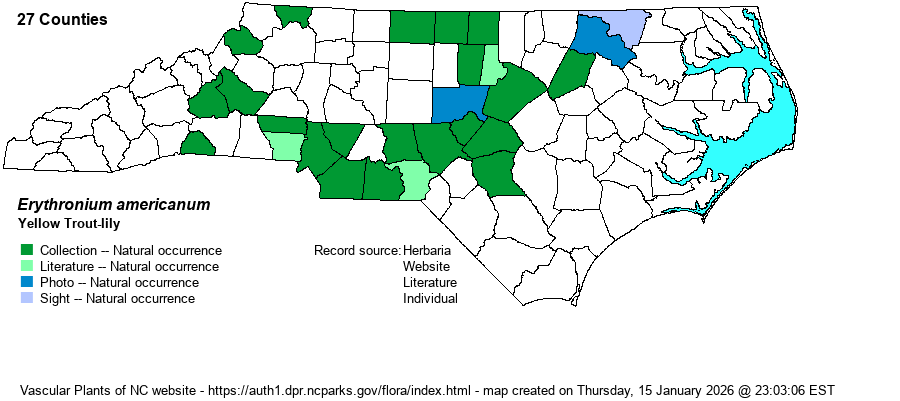| Author | Ker-Gawler | |
| Distribution | It has been 30+ years since Erythronium umbilicatum was described, split out of E. americanum. Nonetheless, the SERNEC database contains quite a few dozens of specimens that are still labeled as E. americanum that, based on geography and location within the county, may well refer to E. umbilicatum, the much more common of the two species in NC. Even some specimens at the NCU herbarium are suspect, but are included on the map below, until taxonomists there examine more closely their Erythronium specimens. In addition, the NCU counties listed as E. americanum in the SERNEC database seem to match the known distribution -- being a species primarily of the Piedmont, extreme upper Coastal Plain (at least along the Roanoke River and Cape Fear River), and perhaps sparingly in the Mountains (at least the northern Mountains). The website editors have also mapped records from other herbaria that specifically say "subsp. americanum". The map below is certainly incomplete, and it likely is present in much or most of the northwestern Piedmont and sparingly in the Mountains -- Weakley's (2022) map shows it as "rare" in that province.
According to Weakley (2022), it is a Northern species, ranging from "NB west to ON and MN, south to sc. NC, c. TN, AR, and OK". The BONAP map is roughly correct, though the sharp dichotomy between records in southern VA and eastern TN (practically all counties in those two states) and the very few in NC indicates either over-representation in those states or under-representation of specimens in NC. | |
| Abundance | Generally uncommon and somewhat local in the Piedmont, quite rare in the northwestern Coastal Plain (upper Roanoke River and upper Cape Fear River), and apparently rare in the Mountains. However, where it occurs, large colonies are often seen, covering many square yards of the ground. It appears to be the dominant of the two species of Erythronium along the upper Roanoke River slopes and floodplain. However, elsewhere in the state where both trout-lilies occur, this species is almost always outnumbered by E. umbilicatum, especially in number of sites. Until a few years ago, the NC NHP had the species on its Watch List, but more information is now available on locations. Because there is still some uncertainty about its range in the state, the "?" after the state rank of S3? is indeed warranted. | |
| Habitat | This species is found mainly in Basic Mesic Forests, as well as on rich Natural Levee Forests of brownwater rivers and in adjacent rich bottomlands. It is limited to very rich, high pH soils, as compared with E. umbilicatum, which grows in more acidic to circumneutral soils. |
| Phenology | Blooms from February into April, but mainly from about mid-March into April. It blooms 1-2 weeks after E. umbilicatum in the same locations. | |
| Identification | The leaves of both species of trout-lilies are easily identified by anyone who spends much time in the woods in spring. Each plant has two basal leaves, each about 5 inches long and 1 inch wide, quite thick, fleshy, and pale green, with a mottling of purple-brown. Both species grow in very extensive colonies, and thus you must have the flowers and capsules to make certain identification, though Weakley (2018) indicates that the stolons can be used for separation. When in bloom, each species has a single flower atop a roughly 6-8-inch tall naked flowering stalk. This species has the 6 bright, rich yellow (almost a golden-yellow) tepals about 1.2 inches long, with each tepal strongly recurved. If you check the inner 3 tepals, each has a small auricle ("ear") at the base, which E. umbilicatum lacks. The latter species has slightly smaller flowers, with tepals about 1 inch long, and they are a medium yellow. (However, this can be tricky to use for identification.) After blooming, E. americanum has a graceful, "swan-like" appearance, as the flower stalk remains erect, with a slight nod at the top such that the capsule is held horizontally or somewhat ascending. Also, the end of the capsule is rounded or pointed, as opposed to "dimpled" or indented or strongly squared-off in E. umbilicatum. As most folks are familiar, when E. umbilicatum is finished blooming, the flower stalk flops to the ground, seemingly not strong enough to keep the capsule off the ground. For most biologists, 95% or more of your encounters with a trout-lily colony will be E. umbilicatum, but you must always be careful before you claim a colony as the relatively scarce E. americanum. As a reminder, this latter species always requires high pH soil, which should eliminate most forested habitats in the Piedmont and upper Coastal Plain. | |
| Taxonomic Comments | See the Distribution section above. Also, as this is a wide-ranging species, Weakley (2018) assigns the NC population to the nominate form -- E. americanum ssp. americanum.
| |
| Other Common Name(s) | American Trout-lily. The sometimes used name of Dogtooth Violet, or Yellow Dogtooth Violet, is strange, misleading, and very idiosyncratic; it should be eliminated, as it is not even close to a violet (which is a dicot genus, not a monocot one). | |
| State Rank | S3? | |
| Global Rank | G5 | |
| State Status | | |
| US Status | | |
| USACE-agcp | | |
| USACE-emp | | |

